by Peter Brooke | Jun 1, 2018 | Articles
I gave a talk recently in Northampton on the paintings and church decoration of Sister Joanna Reitlinger.
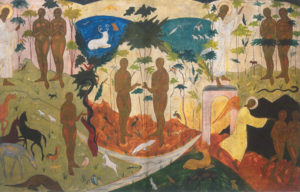
St Anne’s Orthodox Church in Northampton is in the process of installing a series of mural paintings by her originally done for the Society of SS Alban and Sergius when it was based in London. She was a Russian emigré living in Paris and for a while she was part of the Atelier d’Art Sacré founded by the French Catholic painter Maurice Denis. My talk was centred on Denis and on the encounter between Catholic and Orthodox approaches to painting in the early twentieth century. I’ve now posted it on my own website here
I also have a couple of pieces on another part of my website that may be of interest. One of them a general introductory account of the history of Orthodoxy and the other about the early days of the Moscow Patriarchate established, or re-established, in 1917 in the context of the formation of the Bolshevik state.
Peter
by Peter Brooke | Nov 1, 2017 | Poetry
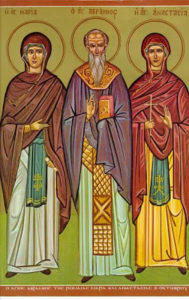
Icon of SS Abramius and Mary, with St Anastasia the Roman, third century martyr also celebrated on 29th October.
My poem is a rather free improvisation on the story. In the Life by St Dmitri of Rostov (it can be consulted here), Mary flees out of an awareness of sinfulness after she has been seduced by a false monk-disciple of her uncle.
The soul, being enormous, cannot fit
this narrow way, even knowing
or at least believing,
or at least thinking
that only beyond or through it
will it find
a space
that is more or less adequate.
I threw myself against the wall,
against a door that is
wide open but
I thought it was too small.
And so I left the little cell
where God walked with my uncle in the cool
of the evening and ran away
to preserve my soul to the ‘big city’
where I walked the streets and was taken
in the arms of this one. And that one.
This enormous soul, still
thrown against the wall.
And my uncle, he
was always with me, weeping,
even a hundred miles away,
because he was in God, knowingly,
and I was in God just because
everything is in God, and that is why
those whose eyes are opened, who see
in God, see everything, and weep
unceasingly.
So my uncle came, looking for me,
presenting himself at the brothel door,
making himself small
and insignificant,
just another
client.
We conversed
that night and our conversation turned
on the enormous pit
that is the longing of the soul and on what
properly corresponds to it.
And so I returned to my uncle’s cell
and I felt like a child that is growing smaller,
a child who is
returning to childhood, to a world
growing ever bigger, an
expanding Universe, Heaven,
seen through a narrow door
a door that the soul can only enter
when it has become
sufficiently
small.
by Peter Brooke | Sep 9, 2017 | Events
There will be a day long seminar on ‘The (Greek, Russian, Bulgarian, Serbian, Rumanian …) Orthodox Church – History – iconography – music Introduced by Dr Peter Brooke on Wednesday 4th October 2017 at Coleg Trefeca (centre of the eighteenth century Welsh Methodist revival).
This is Day 4 of a series of ‘Days of Spiritual Reflection’ organised by Jonathan Morgan
Price: £22.00 (includes 3 course lunch, tea/coffee etc)
Contact Coleg Trefeca, Trefeca, Brecon, Powys LD3 OPP Tel: 01874 711423
by Peter Brooke | Aug 30, 2017 | Discussion
I have a new article published in the Orthodox Arts Journal – From Cubism to the Romanesque (to the Orthodox icon?). It follows on from my previous piece about the attempt of Charlemagne and his court to attack the Seventh Ecumenical Council and the veneration of icons. In that article, drawing on the arguments of the Cubist painter, Albert Gleizes, I drew a distinction between ‘rhythmic’ art and figurative or imitative – representational art. For all its stylisation and ‘abstraction’ the icon is a representational art, it embodies a ‘likeness’ to the Person represented. The question then is what role if any an essentially rhythmic approach, such as was, or may have been, embodied in Romanesque art, can play.
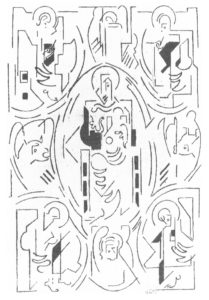
A ‘rhythmic’ Christ in Glory surrounded by the Evangelists by Albert Gleizes.
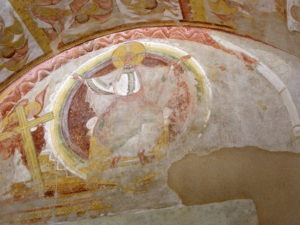
A Romanesque Christ in Glory (St-Savin-sur Gartempe)
Peter
by Peter Brooke | Jul 17, 2017 | Discussion
An article I have written has been published by the online Orthodox Arts Journal under the title The Seventh Ecumenical Council, the Council of Frankfurt and the Practice of Painting. The Seventh Ecumenical Council in 787 AD gave authoritative approval to the veneration of icons. The Council of Frankfurt (794 AD) was summoned by Charlemagne as part of his project of distancing the Western Church from the Roman Empire centred on Constantinople. Charlemagne wanted to condemn the practise of venerating icons but was inhibited by the Pope (Hadrian I). I am arguing that although this was all obviously political there was a real difference between the classical culture of Rome and the culture of the peoples gathered round Charlemagne who had never been part of the Empire, most notably the Celts (Irish and Welsh) and Anglo Saxons (in particular the Northumbrians who had been converted to Christianity from Ireland). The main texts arguing for the veneration of icons, by St John of Damascus and St Theodore the Studite, were unknown in the West, but if they had been known, I suggest that the ‘insular’ monks would not have understood them. The argument was based on the idea that the artist’s job was to produce a likeness of something in the natural world. The insular (Celtic/Anglo Saxon) idea was quite different. I characterise it as ‘rhythmic’ and try to give a summary account of it.
by Peter Brooke | Mar 20, 2017 | Poetry

‘Verily I say unto you, they have their reward’
Matt 6.2
The gratification of being well regarded
is my reward.
My reward is a stone
that pulls me down.
I must get rid
of my reward.
The eyes of men
are so many knives
cutting me up; under their gaze
I become
Legion. I pass like a whore
from one to the other
like so many pieces
of a smashed mirror.
Lusting after praise,
avaricious of praise,
proud of praise,
gluttonous for praise,
envious of praise,
angry at being disregarded and soon
falling into apathy.
That is how the days
pass; to flee
from the snare, I must be
ridiculous,
like Lazarus
lying at the rich man’s gate.
I must climb under
my reward, then, free
of other men’s eyes
I can see
objectively.
I can see the angels
outside the brothels
and round the walls
of the churches the devils
and in the depths
of winter, dressed
only in rags, lying
in the gutter I can taste
the fruits of Paradise.
by Peter Brooke | Feb 23, 2017 | Poetry
Here is a poem……….
IN AN ORTHODOX CHURCH

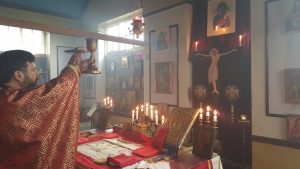
In this place,
everything is still, any
noise is a shock.
No-one is
laughing here,
in this place, above
everything that happens,
above and below
and inside and out.
It requires,
this everywhere,
silence and darkness.
This is the most dear
habitation,
above thinking, here thinking
is a distraction,
demons, dreams and wishes
are only a nuisance.
The vibration of
strong emotion shrinks
this space, which is
normally very big, any
contrary vibration, contrary
space (e.g.
cyberspace)
is ruinous.
In this place what was
continuous has become saccadic,
what was saccadic
has become continuous.
I am living in an un-
finished dot drawing.
This is the house of prayer
where David went.
I am huddled in a dark
corner of his tent.
Here I have not seen God,
but I (and everyone with me)
have known a lovely
darkness from too much light.







Recent Comments